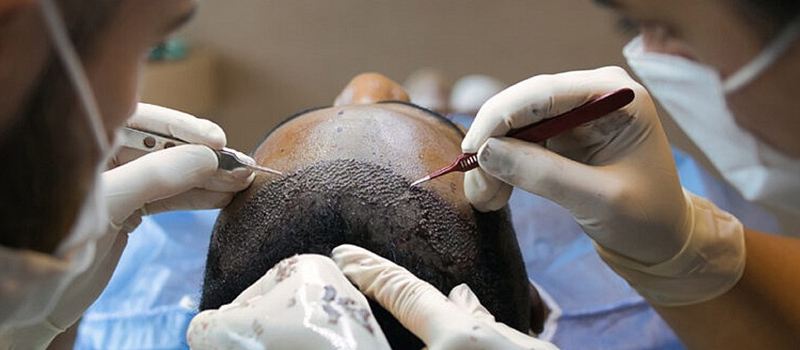Hair transplant and scalp micropigmentation are different methods to minimize the appearance of thinning hair or bald spots. In this article, we share an overview of these procedures and offer some tips on choosing the right procedure for your needs. While this article helps you make an informed decision, we recommend you consult an experienced practitioner for more specific advice after a physical examination of your scalp.

What is a Hair Transplant?
A hair transplant is one of the most popular treatments for thinning hair or bald spots on the scalp. Hair transplant surgery, also known as hair follicular unit restoration (FCU), removes hair from a donor site and inserts that hair into the desired spots on the scalp. The donor site is typically an area of the scalp that has a fuller volume of hair, such as the area around the neck. A hair transplant procedure can be done to improve the appearance of a receding hairline, a thinning crown, or other parts of the scalp.
The harvesting of hair from the donor site and the insertion of that hair into the scalp is done in the same procedure. However, the patient might need multiple sessions to achieve their desired results. A hair transplant procedure is usually pain-free because the scalp is numbed for the procedure. There is a significant recovery period after the surgery. The transplanted hair will take around 3 to 4 months to start growing.
What is Scalp Micropigmentation?
Scalp micropigmentation is like getting a tattoo on the scalp. It is a non-invasive procedure to help provide an appearance of natural hair on the scalp. Small amounts of color or pigments are applied to the scalp. These small pigments appear as tiny hair on the head, similar to a buzz-cut hairstyle. While scalp micropigmentation is most commonly used to make the scalp look fuller with hair, it can also be used to cover birthmarks or scars on the scalp.
The procedure for scalp micropigmentation is not as exhaustive as other alternatives, but the session can last up to 4 to 5 hours. A patient might need more than one session to achieve their desired results. There is minimal downtime with scalp micropigmentation, and most people do not need an extended rest period.
How to Choose?
While both procedures have a similar objective, there are some key differences. Scalp pigmentation is only suitable for candidates who have extremely short hair. On the other hand, a successful hair transplant allows you to keep longer hair. With micropigmentation, you will need to keep the scalp as smooth as possible.
Another disadvantage of scalp micropigmentation is that the pigments will eventually start to fade. The appearance of the pigments depends on several factors, including how skillfully the procedure was performed.
A drawback of getting a hair transplant is the longer recovery period. It will also take longer for a hair transplant to show results. Scalp micropigmentation will deliver immediate results. Since a hair transplant is a surgical procedure, there are inherently greater risks compared to a noninvasive procedure such as scalp micropigmentation.
The cost of both procedures can vary greatly depending on your location, practitioner, scope of procedure, and other factors. Generally, you can expect scalp micropigmentation to be a less expensive procedure compared to a hair transplant.
To choose between a hair transplant procedure and scalp micropigmentation, it is best you consult an experienced practitioner. They examine your scalp and discuss your expectations to guide you on which procedure is more suited to your needs.
